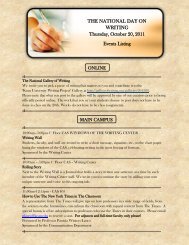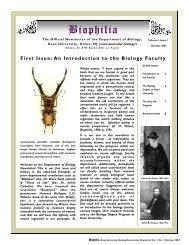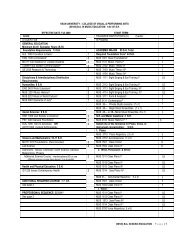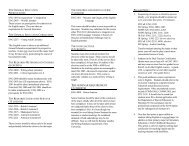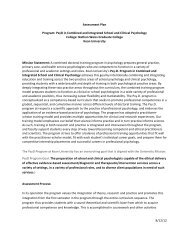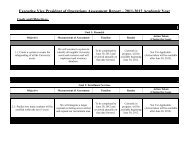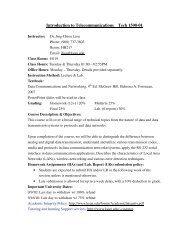Embodying the Sacred in Yoruba Art - Kean University
Embodying the Sacred in Yoruba Art - Kean University
Embodying the Sacred in Yoruba Art - Kean University
You also want an ePaper? Increase the reach of your titles
YUMPU automatically turns print PDFs into web optimized ePapers that Google loves.
num<strong>in</strong>ous <strong>in</strong> <strong>the</strong> quest for <strong>in</strong>dividual and collective empowerment,<br />
both physically and spiritually.<br />
Admittedly, <strong>Yoruba</strong> culture has been undergo<strong>in</strong>g unprecedented<br />
transformations s<strong>in</strong>ce <strong>the</strong> turn of <strong>the</strong> twentieth century ow<strong>in</strong>g to <strong>the</strong><br />
impact of mass conversion to Islam and Christianity, Western education,<br />
modern technology, and <strong>in</strong>creas<strong>in</strong>g urbanization. Yet many <strong>Yoruba</strong> have<br />
not totally abandoned <strong>the</strong>ir ancient customs, syn<strong>the</strong>siz<strong>in</strong>g <strong>the</strong> old with <strong>the</strong><br />
new <strong>in</strong> <strong>the</strong> attempt to cope with <strong>the</strong> dynamics of change.<br />
Babatunde Lawal holds a PhD <strong>in</strong> art history from Indiana <strong>University</strong>, Bloom<strong>in</strong>gton, Indiana,<br />
and has been a professor at Virg<strong>in</strong>ia Commonwealth <strong>University</strong> s<strong>in</strong>ce 1992. Dr. Lawal<br />
specializes <strong>in</strong> African and African Diaspora art with a personal research focus on <strong>the</strong> arts<br />
of Nigeria, particularly <strong>the</strong> visual culture of <strong>the</strong> <strong>Yoruba</strong> and its <strong>in</strong>fluences <strong>in</strong> <strong>the</strong> Americas.<br />
NOTES<br />
1 Ansah 1989: 245.<br />
2 For a general survey, see D’Azevedo 1973: 101–127, 282–340, Hackett 1996: 24–34, 40–42 and Visona, Poynor,<br />
and Cole 2008.<br />
3 For more on <strong>Yoruba</strong> history and archaeology, see Smith 1988 and Willett 1967.<br />
4 See Ojo 1966, Willett 1967, and Drewal, Pemberton, and Abiodun 1989.<br />
5 This deity is popularly called Èsù or Elégba and sometimes ÈsùElégba; hence my use of Èsù/Elégba, while<br />
reta<strong>in</strong><strong>in</strong>g Èsù and Elégba <strong>in</strong> citations.<br />
6 For more details, see Lawal 2007.<br />
7 Akiwowo 1983:11 and Lawal 2001: 515.<br />
8 For details, see Abiodun 1976: 4–20 and Lawal 2001: 498–526. However, if <strong>the</strong> family of <strong>the</strong> deceased cannot<br />
afford a naturalistic portrait, a symbolic one will suffice. This may consist of two sticks shaped like a cross and<br />
draped with <strong>the</strong> garment of <strong>the</strong> deceased.<br />
9 For details, see Lawal 2011.<br />
10 For more on udàmalore, see Drewal, Pemberton, and Abiodun 1989: 109.<br />
11 For details, see Lawal 1985: 91–103 and Lawal 2000: 93–109<br />
12 For details, see Hyde 1998: 7-11.<br />
13 For more on Ifá div<strong>in</strong>ation and iconography, see Bascom 1969, Abimbola 1976, and Drewal, Pemberton, and<br />
Abiodun, 1989.<br />
14 Lawal 2007: 46<br />
15 For an illustration, see Lawal 2007, pl. 30<br />
16 For illustration, see Drewal, Pemberton, and Abiodun 1989: 169 and Lawal 2007: 53.<br />
17 For more on African masquerades, see Huet 1978, Cole 1985, and Hahmer-Herzog. Kecskesi, and Vajda 1998.<br />
18 For details, see Lawal 1996.<br />
19 For details, see Lawal 1996: 126–29.<br />
20 See, for <strong>in</strong>stance, Slogar 2002: 24–26.<br />
21 At Ilaro, <strong>the</strong> headpiece of <strong>the</strong> Efe mask is worn like a wide-brimmed hat but has a human head <strong>in</strong> <strong>the</strong> middle<br />
(for illustration, see Drewal and Drewal 1983, Gelede, pl. 13). It is uncerta<strong>in</strong>, however, whe<strong>the</strong>r <strong>the</strong> hat on this<br />
headpiece has anyth<strong>in</strong>g to do with <strong>the</strong> Ilaro tradition.<br />
22 For more on <strong>the</strong> Epa masquerade, see Carroll 1967, Thompson 1971 and Ojo 1973: 455–70<br />
23




